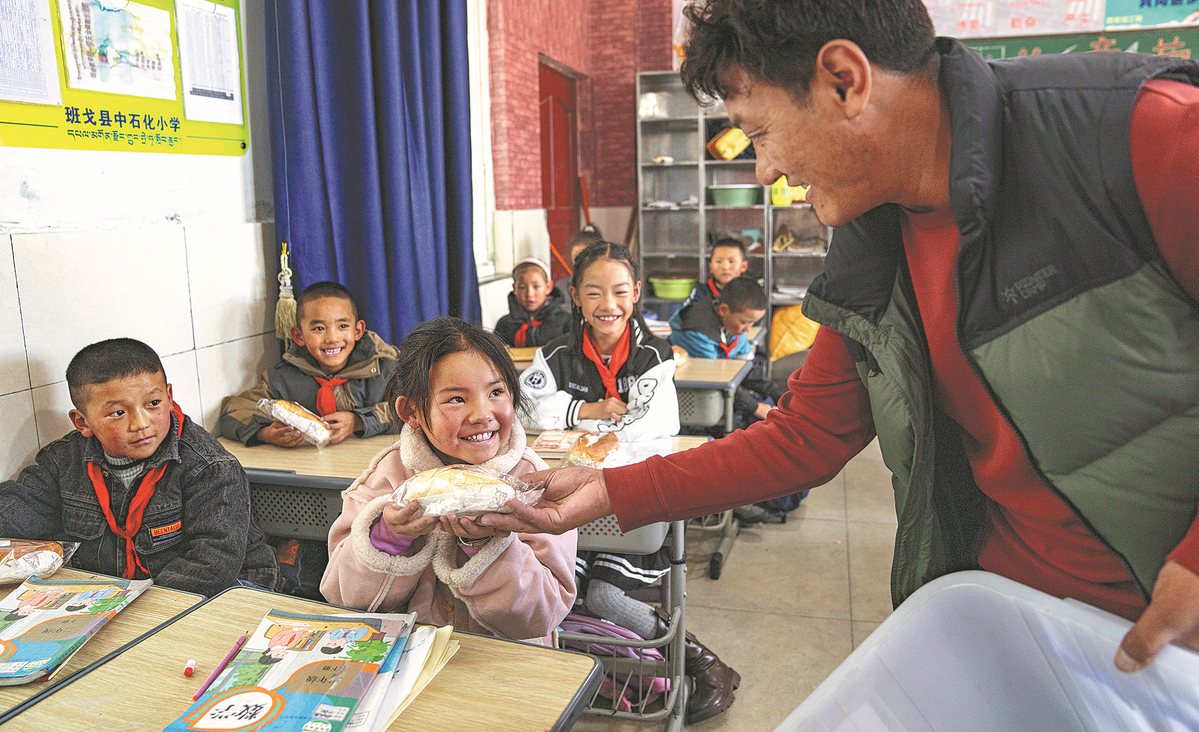
A teacher from a primary school in Palgon county, Xizang, distributes nutritious meals to students on June 22. TENZIN NYIDAR/XINHUA
Thanks to support from the central government — and the efforts of outside provinces, cities, and State-owned enterprises — the Xizang autonomous region has taken great development strides over the past 30 years.
Following decisions and arrangements made by the central government, the Organization Department of the CPC Central Committee and other central authorities have dispatched 10 batches of nearly 12,000 cadres and skilled workers to the region over the past three decades.
Song Liqiang, deputy head of the regional organization department and team leader of the 10th group sent to aid Xizang, said the number of people being sent to the region had gradually increased from 622 at the beginning to 2,117 in the latest effort.
Over the 30 years, nearly 10,000 orphans and impoverished students have been given support, while more than 8,300 patients with congenital heart disease, cataracts, and skeletal diseases have received free treatment, Song said.
"The Aid Xizang project has promoted the high-quality development of the plateau economy," he said.
"Using industrial parks and scenic projects, it has promoted the development of Xizang's advantageous industries, attracting over 1,140 enterprises, and creating hundreds of distinctive brands," Song said.
Beneficiaries of the assistance range from performers and producers of the Princess Wencheng opera to a vegetable plantation in Panam county. All the projects have facilitated "the transformation and upgrading of the Tibetan economy," Song said.
In 1994, the central government decided to rally national support for Xizang under the policy of "pairing-up" assistance for the region. Seventeen provinces and cities as well as 78 central State organs and people's organizations and 27 centrally administered State-owned enterprises were designated to assist in specific areas of Xizang to stimulate the development of the plateau region.
Since the 18th National Congress of the Communist Party of China in 2012, more than 9,500 assistance projects have been implemented in Xizang.
The projects focus on what Xizang needs and the aspirations of the people, Song said. In 2023 alone, this strategy attracted 25.17 billion yuan ($3.5 billion) in investment and 146 high-level talents, he added.
Assistance has also been provided for the construction of an ecological civilization in Xizang through major environmental work such as afforestation, greening projects, desertification control, grassland ecological protection, and restoration work along the region's major rivers.
In order to consolidate border areas and benefit residents, projects such as construction and renovation of municipal facilities, improvement of living environments, enhancement of public services, and beautification work have been implemented.
The assistance has also accelerated urbanization in border counties, and developed industries such as logistics, tourism, mineral resources, and clean energy, Song said.
Ethnic groups in Xizang have seen their lives drastically improve, particularly through the upgrading of healthcare and medical facilities.
The Xizang Autonomous Region People's Hospital has steadily advanced to achieve "triple A" status, and people's hospitals in six cities, including Lhasa, are now also classified at this level.
Chen Pu, a researcher at the Economic Strategy Research Institute of the Xizang Academy of Social Sciences, said that the assistance project has effectively promoted the development, stability, and security of the region, and improved people's livelihoods.
"Amid the national economic downturn, the overall effectiveness of group-assisted aid and intellectual aid to Xizang has continued to expand and advance, supporting pillar industries, key areas, key products, and crucial technologies in the assisted areas," said Chen.
"This has facilitated the transformation of Xizang's resource advantages into economic strengths, propelling the region's major economic indicators since the 14th Five-Year Plan period (2021-25)."
palden_nyima@chinadaily.com.cn
